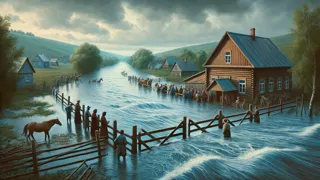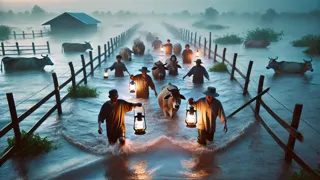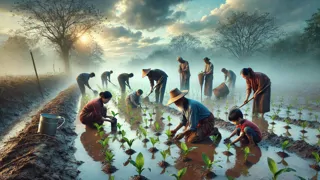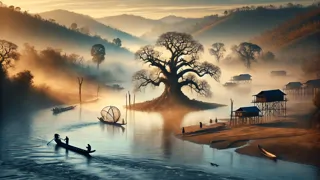Introduction
A pale dawn spilled gold across the Mississippi’s broad current, wreathing the river’s curve in silent promise. Fishermen preparing nets paused, sensing the hum of hidden currents beneath the surface. At the edge of the forested bank, ancient cottonwoods stood sombre guard as dawn mist drifted among their roots. From the high bluff above, the wind carried whispered warnings from beyond memory: stories of waters that once rose higher than treetops, reshaping the land and spirit of everyone who lived along those storied shores. Children would gather at the hearth that night to hear the elders recall how the river rewarded respect and punished neglect. As the sun climbed, the village prepared its yearly offering—corn and tobacco, laid at the water’s edge to honor the spirits of river and soil. Unseen currents shifted beneath stone and root, and the river murmured back. This was no ordinary season. The great flood approached, and with it came a lesson in humility, unity, and reverence for every living thing that called this fertile floodplain home.
Whispers of the Rising Waters
The early stirrings were almost imperceptible. Fishermen found their nets heavier than usual, and the sun rose through thicker mist that clung to every willow branch. On the high bluff, an old storyteller named Wapasha gathered children close, her voice low but urgent as she recounted an ancient prophecy: "When the river sings in thunderous voice, it will claim both heart and land until those who live beside it remember the old covenants." That very afternoon, the river’s tone shifted from gentle murmur to a deep, rolling cadence, foreshadowing a swell beyond any elder’s living memory. Farmers hurried to harvest their last rows of corn, and families carried livestock to higher ground. Horses sensed the shift too, stamping and whinnying as if understanding a change in fate.

Trial of Torrents
Night fell with a roar. Rain pounded roofs, flooding fields in minutes. The river breached its banks and in black darkness tumbled through lanes and pastures, snapping fences and carrying debris like driftwood in a giant wash. Families clung to porches, their faces illuminated by flickering lantern light. In the river’s dependably placid bends now grew currents that threatened to pull entire houses into the swirling depths. Amid the chaos, Wapasha marched through the deluge, calling for calm and reminding everyone of the offerings laid that morning. "Honor goes both ways," she called over the wind. "We gave thanks; now we must show respect in return."

They waded into the water together, guiding stranded cattle, untying boats for rescue, and chanting soft prayers to the river spirits. Because they honored the old ways—sharing food, sparing no kindness, and giving thanks—the torrent’s fury eased. By dawn, the worst had passed, and though the flood had carved new channels and reshaped the shore, all souls remained safe.
Renewal of the Land
As waters slowly receded beneath a cloud-brushed sky, the community emerged onto mud-crusted fields and ruined fences. Yet the devastation bore signs of nature’s renewal: new fish trapped in shallow pools, fresh silt coating the fields with mineral-rich earth, and young willow shoots that bent but did not break. Wapasha led a dawn ceremony at the river’s edge, planting corn kernels, scattering tobacco leaves, and speaking words of gratitude for protection and mercy. Children helped shape small earthen figures of animals and set them afloat downstream, carrying messages of hope and cooperation.

Over the following weeks, neighbors labored side by side to rebuild cottages and bridges, their efforts weaving stronger bonds. Their river, once feared, became a source of pride and respect. Regular offerings resumed—simple tokens that reminded every generation of the delicate balance between human need and natural power. In time, the floodplain flourished richer than before, teaching that waters which can destroy in their impatience can also restore in their abundance. The Story of the Flood became a living legacy, a cautionary and celebratory tale shared around every hearth as both warning and blessing.
Conclusion
The great flood left scars in wood and soil, but deeper still, it etched a lesson of humility and reverence into every heart. In the years that followed, people told their children of the morning when dawn mist turned to torrent, and how respect for river and land turned disaster’s rage into a force of renewal. Offerings of corn and tobacco, simple acts of thanks, became rituals passed from elder to child. And when spring rains swelled the banks once more, no one feared the water. Instead, they greeted it as teacher and ally, mindful that nature’s power demands gratitude, unity, and care if every life is to flourish along the floodplain’s edge. That is the legacy of our river, an enduring promise that harmony with the land can transform even the fiercest flood into a gift of new life and community resilience.|,

















